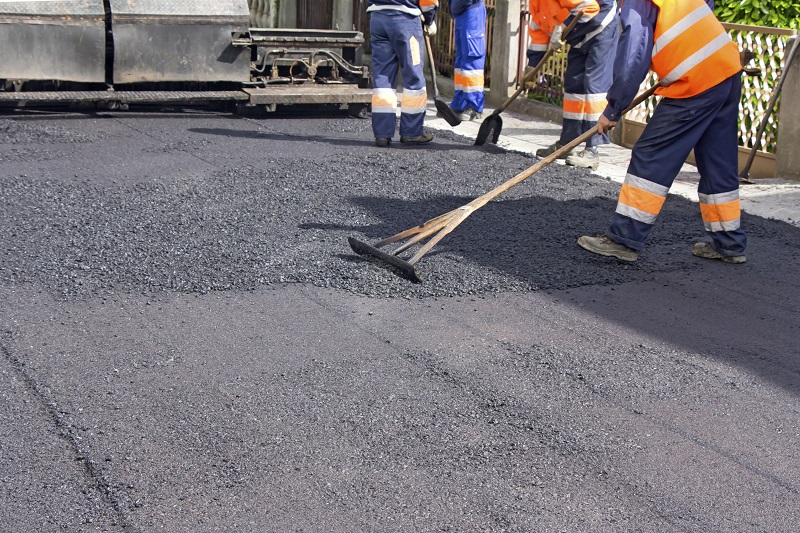Change Your Property's Landscape with Hot Mix Asphalt Paving Excellence
Change Your Property's Landscape with Hot Mix Asphalt Paving Excellence
Blog Article
Unlocking the Secrets of Hot Mix Asphalt Modern Technology
Checking out the midsts of hot mix asphalt innovation discovers a globe where careful processes and exact formulas assemble to shape our roads and framework. The blend of binders, aggregates, and fillers isn't just a construction job yet a critical orchestration of longevity and performance. As we peer right into the complex dancing of elements, a tapestry of resilience and sustainability unfolds. Yet what exists below this surface of asphaltic proficiency, and what keys wait to be revealed in the realm of leading advancements?
Significance of Warm Mix Asphalt
Warm Mix Asphalt plays an essential function in contemporary framework growth due to its longevity and cost-effectiveness. As the most commonly utilized leading material for roads, highways, and auto parking lots, Warm Mix Asphalt offers an array of advantages that add to its relevance in building and construction tasks.
The longevity of Hot Mix Asphalt stems from its make-up, that includes accumulations, binder, and filler products that are carefully chosen and blended to satisfy particular performance requirements. This precise mix leads to a solid and adaptable pavement that can sustain constant use without considerable wear and tear. Hot Mix Asphalt is 100% recyclable, further boosting its sustainability and ecological benefits. Overall, the value of Warm Mix Asphalt in framework development can not be understated, as it proceeds to be a foundation of modern building and construction methods.
Components of Asphalt Mixes
The composition of asphalt mixes consists of carefully selected aggregates, binder, and filler materials that are vital for attaining specific performance demands. Aggregates are the primary element of asphalt mixes, offering toughness and security. The binder, generally bitumen or asphalt cement, holds the aggregates together and offers versatility and toughness to the mix.
The mix and percentage of these parts play a significant duty in determining the quality and performance of the asphalt mix. Designers meticulously design the mix to meet specific needs, taking into consideration variables like web traffic quantity, climate problems, and pavement lifespan. Appropriate option and harmonizing of aggregates, binder, and fillers are essential for producing durable, lasting asphalt pavements.
Mixing and Production Strategies

As soon as the accumulations are picked, the binder, often asphalt concrete, is included in bind the products with each other. The binder's quality and quantity considerably affect the mix's resistance, toughness, and adaptability to environmental factors. Additionally, fillers like hydrated lime or Rose city concrete may be incorporated to boost details features of the asphalt mix, such as its workability or wetness resistance.
During production, the accumulations and binder are heated up, usually between 250-325 ° F(121-163 ° C ), to facilitate blending and guarantee proper coating of the accumulations. The mixing procedure has to be complete to achieve an uniform blend that promotes the wanted efficiency characteristics of the asphalt. Numerous methods, such as batch blending or drum mixing, are used to achieve premium and consistent asphalt blends for building projects.
Aspects Affecting Asphalt Efficiency
Factors influencing asphalt efficiency incorporate a range of variables that affect the longevity, durability, and general top quality of asphalt pavements. One essential aspect is the top quality of products used in the asphalt mix.

Environmental conditions additionally influence asphalt efficiency. Temperature variants, dampness infiltration, and web traffic tons can all influence the structural honesty of the pavement. Style factors to consider, such as pavement thickness and water drainage, are vital in ensuring the lasting performance of the asphalt sidewalk. By thoroughly taking into consideration these elements, engineers and contractors can maximize asphalt efficiency and enhance the life span of pavements.
Sustainable Practices in Asphalt Modern Technology

Furthermore, the growth of warm-mix asphalt (WMA) technologies has obtained grip in current years. WMA enables the production and positioning of asphalt mixes at lower temperature levels contrasted to conventional hot-mix asphalt, causing reduced energy consumption and greenhouse gas exhausts. Moreover, making use of permeable asphalt blends can help mitigate stormwater drainage issues by permitting water to penetrate through the sidewalk and right into the ground, promoting all-natural water filtering and recharge procedures. By implementing these lasting practices, the asphalt market can add to developing a much more resilient and eco pleasant framework network.
Conclusion
Finally, warm mix asphalt modern technology plays an important function in modern-day framework Visit Website growth because of its toughness and cost-effectiveness. By carefully balancing components, employing correct mixing methods, and thinking about different elements, engineers can produce premium asphalt mixes that endure heavy traffic loads and harsh weather. Welcoming sustainable methods, such as utilizing recycled materials and warm-mix technologies, better boosts the environmental friendliness of asphalt technology.
Blending and manufacturing techniques in warm mix asphalt innovation involve the hop over to here precise mix and processing of accumulations, binder, and fillers to produce a long lasting and high-performance asphalt mix.Factors affecting asphalt performance encompass an array of variables that influence the resilience, long life, and general quality of asphalt sidewalks. Sustainable techniques in asphalt innovation encompass numerous efforts intended at minimizing the environmental influence of asphalt production and paving procedures. By including redeemed asphalt pavement (RAP) and recycled asphalt tiles (RAS) right into brand-new asphalt mixes, the sector can substantially decrease the intake of raw materials and power, while also reducing garbage dump waste.
WMA enables for the manufacturing and placement of asphalt blends at lower temperatures contrasted to conventional hot-mix asphalt, resulting in lowered energy usage and greenhouse gas emissions.
Report this page